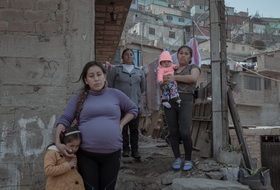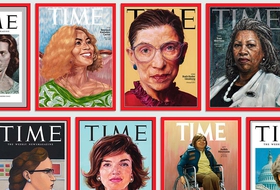
One in three women have suffered physical or sexual violence. With contributions from Europe, Africa, Asia and Latin America, we look at how this shadow pandemic affects every corner of the world.
One of the best ways to understand how a woman feels with a burqa on is wearing one. This, according to a man who marched on Thursday 5th March in the streets of Kabul, capital of Afghanistan, wearing a cobalt blue burqa under a dull grey sky. The demonstrators, who were about two
One of the best ways to understand how a woman feels with a burqa on is wearing one. This, according to a man who marched on Thursday 5th March in the streets of Kabul, capital of Afghanistan, wearing a cobalt blue burqa under a dull grey sky.
The demonstrators, who were about two dozen, claimed to be associated with the Afghan peace volunteers and to give their support to women’s rights ahead of the International Women’s Day, on 8 March.
Burqa is an enveloping garment that covers women from head to toe, face included and that allow them to “see” just through a concealing net about the eyes. The use of burqa dates back to the XIX century, but it was imposed in the 90s under the Taliban regime that was overthrown with the western invasion led in response to the 2001 Twin Towers attacks in New York, United States.
All were astonished by the march, including policemen and women who bumped into men in burqa. Many protesters affirmed they felt as if “in jail” and for this reason they called for equal rights for men and women. A difficult condition to obtain since many adult and old women wear it out of habit: “My husband and son tell me I should take my burqa off. But I’m used to it. I’ve been wearing this for 35 years” said 60 year-old Bibi Gul, a woman interviewed by the Reuters.
Siamo anche su WhatsApp. Segui il canale ufficiale LifeGate per restare aggiornata, aggiornato sulle ultime notizie e sulle nostre attività.
![]()
Quest'opera è distribuita con Licenza Creative Commons Attribuzione - Non commerciale - Non opere derivate 4.0 Internazionale.
One in three women have suffered physical or sexual violence. With contributions from Europe, Africa, Asia and Latin America, we look at how this shadow pandemic affects every corner of the world.
The Istanbul Convention against gender-based and domestic violence marks its tenth anniversary. We look at what it is, who its signatories are, and what the future might hold.
European Commission President Ursula von der Leyen reminded us of the gravity of violence against women around the world, and of the Istanbul Convention’s utmost importance.
President Erdoğan has pulled Turkey out of the Istanbul Convention, key in the fight against gender violence, claiming that it favours the LGBT community rather than family values.
Violence against women in Peru has increased as a result of Covid-19 lockdowns. 14,912 people were reported missing from January to November 2020, more than half of them minors and 64 per cent women. People have been confined to their homes for months, many forced to endure poor physical, economic and social conditions. A situation that
Joys Estefani Qqueccaño Huamani, 24, disappeared from her rural community in Peru on 9 October. Her family began looking for her independently of the authorities and despite the resistance of relatives of Joys Estefani’s ex-partner Arturo Ccana Condori, 32, charged with committing violence against her on 28 September, eleven days before Joys Estefani disappeared. Photos
Costa Rica celebrated its first same-sex marriage when two women, Alexandra Quiros and Dunia Araya, celebrated their wedding: an “extraordinary moment”.
The pandemic and its restrictions are affecting everyone, without exceptions. However factors like housing, income inequalities, gender, access to technology and working conditions are influencing how people experience the health crisis.
Time magazine’s 100 Women of the Year project sheds light on influential women’s stories, from Amelia Earhart to Greta Thunberg. A selection of some of the greats for International Women’s Day.







